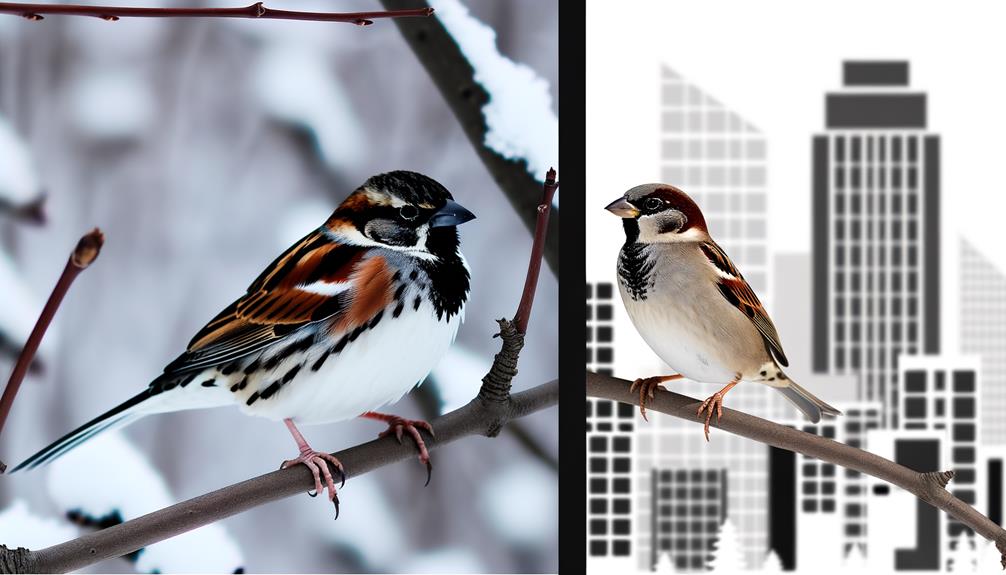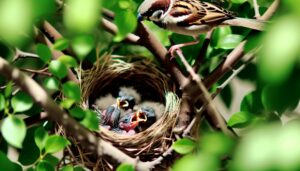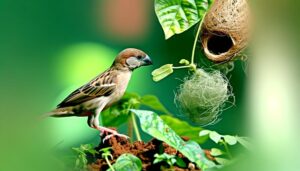3 Key Differences Between Harris Sparrow Vs House Sparrow
Harris's Sparrows and House Sparrows differ significantly in several aspects. Harris's Sparrows have a black crown, face, and bib with a pink bill, measuring 18-19 cm in length, while House Sparrows show sexual dimorphism with males having a gray crown and black bib.
Geographic distributions vary, with Harris's Sparrows in central North America and House Sparrows widely spread, often in urban areas. Migration patterns also differ; Harris's Sparrows undertake long-distance migrations, whereas House Sparrows are largely sedentary.
Their habitat preferences, feeding habits, nesting behaviors, and interactions with humans further reflect their ecological adaptation strategies. Discover more about these fascinating birds by exploring their distinct characteristics.

Key Takeaways
- Harris's Sparrow has a black crown and pink bill, while House Sparrow males have a gray crown and chestnut nape.
- Harris's Sparrow migrates seasonally between Canada and the central US; House Sparrow is largely sedentary.
- Harris's Sparrow prefers dense forests and shrublands; House Sparrow thrives in urban and suburban environments.
- Harris's Sparrow forages primarily on the ground for seeds and insects; House Sparrow consumes a varied diet, including human food scraps.
- Harris's Sparrow is reclusive around humans; House Sparrow actively nests in human-made structures and environments.
Physical Characteristics
The physical characteristics of Harris's Sparrow (Zonotrichia querula) and House Sparrow (Passer domesticus) exhibit distinct differences that facilitate their identification in the field. Harris's Sparrow is noted for its black crown, face, and bib combined with a gray nape and pink bill, with juveniles showing a more streaked appearance. It typically measures about 18-19 cm in length.
In contrast, the House Sparrow features a robust body, with males displaying a gray crown, black bib, and chestnut nape, while females and juveniles are mainly brown with streaked backs. This species averages around 14-16 cm in length.
These morphological distinctions are critical for accurate field identification and contribute to the understanding of their respective behaviors and ecological niches.
Geographic Distribution
Harris's Sparrow primarily occupies the central regions of North America, particularly during its breeding season in the boreal forests of Canada and its winter migration to the central United States. This species is prominently found in areas characterized by dense coniferous and mixed forests.
In contrast, the House Sparrow exhibits a more cosmopolitan distribution, being native to most of Europe, the Mediterranean region, and Asia. Since its introduction to North America in the 19th century, the House Sparrow has successfully established populations across urban and rural environments throughout the continent. Its adaptability to diverse habitats, including agricultural and urban settings, has facilitated its widespread presence.
This distinct geographic distribution underscores the ecological versatility and varying habitat preferences of both sparrow species.
Migration Patterns
The migration patterns of Harris's Sparrow and House Sparrow exhibit significant variations, particularly with regards to seasonal migration behaviors and geographic range.
Harris's Sparrow engages in long-distance migrations between its breeding grounds in northern Canada and wintering habitats in the central United States.
In contrast, the House Sparrow is largely sedentary, displaying minimal migratory behavior, which reflects its extensive environmental adaptability and widespread geographic distribution.
Seasonal Migration Differences
While House Sparrows exhibit limited migratory behavior and tend to remain within their established territories year-round, Harris's Sparrows undertake extensive seasonal migrations between their breeding grounds in the Canadian tundra and wintering habitats in the central United States.
This significant migratory movement is driven by the need to exploit different ecological niches. Harris's Sparrows migrate southward as temperatures drop and food resources become scarce in the northern latitudes.
Conversely, House Sparrows have adapted to urban and suburban environments, finding consistent food sources and shelter, thereby negating the necessity for long-distance migration.
The stark contrast in their migratory behavior underscores the differing evolutionary strategies each species employs to survive and thrive within their respective habitats.
Geographic Range Variations
Examining the geographic range variations between Harris's Sparrows and House Sparrows reveals distinct patterns influenced by their contrasting migratory behaviors.
Harris's Sparrows (Zonotrichia querula) exhibit a well-defined migratory route, breeding exclusively in the boreal forests of northern Canada and wintering in the central United States.
In contrast, House Sparrows (Passer domesticus) are largely sedentary, with established populations across urban and rural areas worldwide. Their geographic dispersion results from human activity, aiding their spread across continents.
The migratory behavior of Harris's Sparrows underscores a narrow geographic range, while the non-migratory House Sparrows demonstrate a broad, global distribution. These differences highlight the ecological and evolutionary strategies underlying their respective geographic range variations.
Environmental Adaptations
Migration patterns of Harris's Sparrows and House Sparrows reveal significant environmental adaptations that reflect their differing survival strategies and ecological niches.
Harris's Sparrows undertake long-distance migrations, traveling between their breeding grounds in the northern boreal forests of Canada and their wintering habitats in the central United States.
Conversely, House Sparrows are largely sedentary, exhibiting minimal migratory behavior due to their adaptability to urban environments and year-round food availability.
Key distinctions include:
- Harris's Sparrows: Long-distance migrants, seasonal habitat shifts.
- House Sparrows: Primarily sedentary, urban and suburban adaptability.
- Ecological Niches: Harris's Sparrows rely on natural seasonal changes, whereas House Sparrows thrive in human-modified environments.
These patterns underscore the species' unique evolutionary adaptations to their respective environments.
Habitat Preferences
Habitat preferences for Harris Sparrows and House Sparrows are distinctly shaped by their respective ecological requirements and geographical distributions.
Harris Sparrows (Zonotrichia querula) inhabit the boreal forests and shrublands of central Canada, particularly favoring areas with dense underbrush and a mix of coniferous and deciduous trees. During migration and winter, they can be found in open woodlands and brushy fields across the central United States.
Conversely, House Sparrows (Passer domesticus) show a strong affinity for urban and suburban environments worldwide. Originating from Europe and Asia, these birds thrive in areas with abundant human activity, including cities, towns, and agricultural landscapes. Their adaptability to diverse human-modified habitats has facilitated their widespread global distribution.
Feeding Habits
The feeding habits of Harris Sparrows and House Sparrows exhibit distinct differences in diet preferences, foraging locations, and feeding patterns.
Harris Sparrows primarily consume seeds and insects, often foraging on the ground in open areas. They display more solitary foraging behaviors.
House Sparrows, on the other hand, have a more varied diet that includes grains, fruits, and human-provided food. They are commonly found in urban settings and form highly social feeding groups.
Diet Preferences
Both Harris's Sparrows and House Sparrows exhibit distinct diet preferences that reflect their adaptive strategies and ecological niches.
Harris's Sparrows primarily consume seeds, particularly during the winter months, supplementing their diet with insects and berries when available.
In contrast, House Sparrows demonstrate a more opportunistic feeding behavior, consuming a varied diet that includes grains, seeds, and human food scraps.
These dietary differences underscore the ecological adaptability of each species, with Harris's Sparrows being more specialized and House Sparrows exhibiting broader dietary flexibility.
Foraging Locations
Examining the foraging locations of Harris's Sparrows and House Sparrows reveals how their dietary preferences influence their spatial feeding habits.
Harris's Sparrows primarily forage on the ground in open woodlands, grasslands, and shrubby areas, where they search for seeds, insects, and berries. Their tendency to frequent less disturbed habitats aligns with their preference for a diet rich in native plant seeds and arthropods.
Conversely, House Sparrows, adapted to urban and suburban environments, commonly forage in human-modified landscapes such as parks, gardens, and streets. They exploit food sources like breadcrumbs, food waste, and cultivated grains, reflecting their omnivorous diet and synanthropic nature.
The distinct foraging locations highlight the ecological niches occupied by these two sparrow species.
Feeding Patterns
Diverging significantly in their feeding patterns, Harris's Sparrows exhibit a preference for ground foraging, where they meticulously search for a variety of seeds, insects, and berries. This behavior aligns with their primary diet of natural food sources, including seeds from grasses and weeds, insects such as beetles and caterpillars, and berries during certain seasons.
On the other hand, House Sparrows demonstrate a more opportunistic feeding behavior, readily consuming available human-provided food sources in urban settings. Their flexible feeding habits include eating leftover human food, commercial birdseed, and insects and plant materials in their vicinity. This difference in feeding behavior is reflective of their respective ecological niches and adaptability.
This comparative analysis underscores the varying ecological strategies employed by these two sparrow species.
Breeding Behavior
Breeding behavior in Harris Sparrows, Zonotrichia querula, and House Sparrows, Passer domesticus, exhibits significant differences regarding nesting sites, mating rituals, and parental roles.
Harris Sparrows engage in elaborate courtship displays, involving vocalizations and physical posturing to attract mates. In contrast, House Sparrows employ simpler mating rituals, often characterized by quick, repetitive chirping and chasing behaviors.
Parental roles also diverge between these species. In Harris Sparrows, both sexes participate actively in feeding and protecting the young, demonstrating a high degree of biparental care. Conversely, in House Sparrows, females primarily undertake the nurturing duties, while males mainly focus on territory defense and additional mating opportunities.
These distinctions reflect adaptive strategies tailored to their respective ecological niches.
Nesting Sites
In examining the nesting sites of Harris Sparrows and House Sparrows, key differences emerge in their preferred nest locations and choices of nesting materials.
Harris Sparrows typically construct their nests on the ground in shrubby or grassy areas, utilizing materials such as grass, moss, and feathers.
Conversely, House Sparrows favor urban and suburban environments, often building nests in crevices of buildings or man-made structures, and employing diverse materials including twigs, paper, and string.
Preferred Nest Locations
Although both the Harris Sparrow and House Sparrow exhibit preferences for distinct nesting sites, their choices are influenced by varying ecological requirements and habitat availability.
The Harris Sparrow typically selects nesting locations within boreal forests, choosing sites with dense understory vegetation to provide cover and protection.
In contrast, the House Sparrow is more adaptable, favoring urban and suburban environments where human structures offer ample nesting opportunities.
Understanding these preferences underscores the species' adaptability to their respective environments and their nesting strategies.
Nesting Material Choices
Distinct differences exist in the nesting material choices of the Harris Sparrow and House Sparrow, reflecting their unique ecological niches and nesting strategies.
Harris Sparrows, typically found in boreal forests and tundra regions, utilize natural materials such as grasses, mosses, and lichens, which provide insulation and camouflage amidst their rugged habitats.
In contrast, House Sparrows, highly adaptable urban dwellers, often incorporate anthropogenic materials like paper, string, and synthetic fibers into their nests. This behavior underscores their ability to thrive in human-altered environments. Additionally, House Sparrows also use natural elements like twigs and feathers, indicating a versatile approach to nesting.
Understanding these material preferences highlights the species-specific adaptations that facilitate their survival in diverse ecosystems.
Vocalizations
Harris's Sparrow and House Sparrow exhibit distinct vocalizations, characterized by variations in pitch, frequency, and complexity of their calls. Harris's Sparrow produces a series of clear, whistling notes that often ascend in pitch, typically used for mating and territorial purposes.
In contrast, the House Sparrow's calls are more variable, featuring a combination of chirps and cheeps that serve multiple functions including communication within flocks and signaling alarm.
Key differences in vocalizations include:
- Pitch: Harris's Sparrow emits higher, more melodic notes.
- Frequency: House Sparrow calls are more frequent and repetitive.
- Complexity: Harris's Sparrow's songs are simpler, while House Sparrow displays a broader range of vocal sounds.
These vocal distinctions are vital for species identification and understanding avian communication.
Interaction With Humans
Understanding the unique vocalizations of Harris's Sparrow and House Sparrow provides a foundation for examining how these species interact with human environments. Harris's Sparrows are generally more reclusive, occupying dense brush and forest edges away from urban settings, thereby limiting direct human interaction.
Conversely, House Sparrows are highly adaptable and thrive in human-modified landscapes, including cities and agricultural areas. Their ability to exploit human structures for nesting and their omnivorous diet, often supplemented by human food waste, facilitates their widespread presence in urban areas.
This adaptability makes House Sparrows more visible and interactive with humans, frequently forming flocks that can be both beneficial for pest control and problematic due to their nesting habits and competition with native bird species.
Conservation Status
The conservation status of Harris's Sparrow and House Sparrow differs greatly due to their varying habitat preferences and adaptability to human-modified environments.
Harris's Sparrow (Zonotrichia querula) is listed as Near Threatened on the IUCN Red List, largely due to habitat loss in its breeding grounds and migratory pathways.
In contrast, the House Sparrow (Passer domesticus) is categorized as Least Concern, reflecting its ability to thrive in diverse and urban habitats globally.
- Harris's Sparrow: Near Threatened due to habitat degradation.
- House Sparrow: Least Concern, highly adaptable to urban areas.
- Contributing Factors: Human activities, environmental changes, and adaptability.
Understanding these distinctions is essential for implementing targeted conservation strategies to protect these species.
Conclusion
The Harris Sparrow and House Sparrow exhibit distinct differences across various biological and ecological parameters. Like two branches on a tree, their physical characteristics, geographic distribution, and behaviors diverge notably.
Both species demonstrate unique adaptations to their respective environments, influencing their feeding habits, nesting sites, and interactions with humans. Understanding these distinctions is vital for informed conservation efforts, as each species faces different ecological pressures and conservation needs.
Consequently, tailored strategies must be adopted to guarantee their survival.






